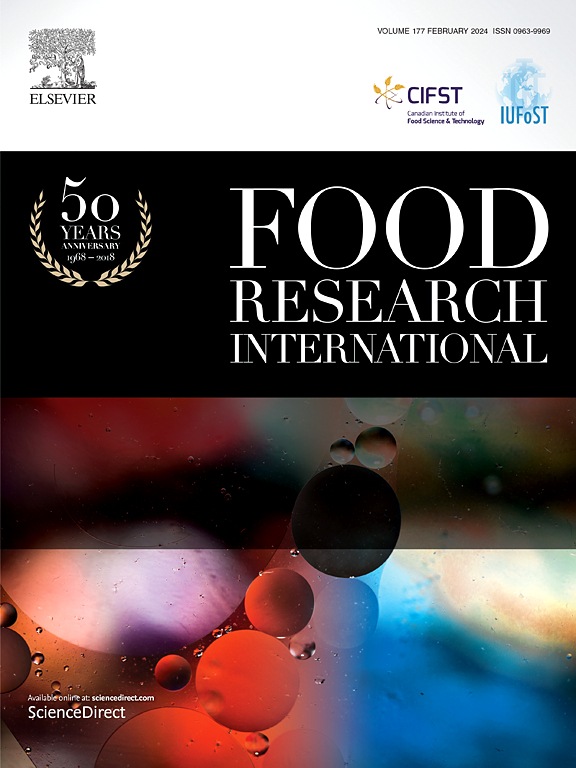纳豆发酵和熟后营养成分和香气化合物形成的动态变化特征
IF 8
1区 农林科学
Q1 FOOD SCIENCE & TECHNOLOGY
引用次数: 0
摘要
发酵和后成熟在纳豆的营养价值、味道和香气的形成中起着重要的作用。本研究旨在分析纳豆在发酵和成熟过程中的营养变化趋势,鉴定其挥发性有机化合物(VOCs)特征,并阐明其形成途径。本研究采用HS-GC-IMS结合感官评价法进行VOCs检测。关键营养成分、蛋白质二级结构和质地特征的动态变化也进行了检测和相关分析。在发酵阶段,每隔4 h观察至20 h,肽和氨基酸含量因蛋白质水解而增加,硬度、弹性和咀嚼性持续下降,粘附力增加。熟后20 h,除硬度继续下降外,其余营养成分和质地性质保持相对稳定。该研究确定了41种挥发性有机化合物,并根据计算的相对气味活性值(ROAV),在整个过程中,有7种化合物的ROAV大于1。此外,与发酵阶段相比,2,3-二甲基吡嗪和2-乙基-3-甲基吡嗪的浓度显著升高(p <;0.05)。此外,研究还发现纳豆中与Phe、Tyr、Val、Ile和Thr含量显著相关的独特香气化合物包括乙酸丁酯、2-甲氧基-3-甲基吡嗪、2-戊基呋喃、丙酸乙酯和2,3-丁二酮(p <;0.05)。综上所述,本研究为纳豆中多种香气化合物的形成提供了有价值的见解,为生产营养价值更高、质地柔软、香气丰富、醇厚的优质纳豆奠定了理论基础。本文章由计算机程序翻译,如有差异,请以英文原文为准。

Characterisation of dynamic changes in nutritional components and aroma compound formation in natto during fermentation and post-ripening
Fermentation and post-ripening plays a significant role in shaping the nutritional value, taste, and aroma of natto. This study aimed to analyse nutritional trends in natto during fermentation and ripening, identify its characteristic volatile organic compounds (VOCs), and elucidate their formation pathways. VOCs were detected using HS-GC-IMS combined with sensory evaluation in the study. Dynamic changes in key nutritional components, protein secondary structure, and texture characteristics were also examined and correlated. During the fermentation phase observed every 4 h till 20 h, peptide and amino acid content increased due to proteolysis, accompanied by a continuous decrease in hardness, springiness, and chewiness, and an increase in adhesion. During the post-ripening stage over 20 h, the overall nutrient composition and textural properties remained relatively stable, except hardness, which continued to decrease. The study identified 41 VOCs and based on the calculated relative odour activity value (ROAV), 7 compounds had ROAVs above 1 throughout the process. Moreover, compared to the fermentation stage, the concentrations of 2,3-dimethylpyrazine and 2-ethyl-3-methylpyrazine were significantly increased (p < 0.05) in the post-ripening. Furthermore, the study revealed that the distinctive aroma compounds in natto, which were significantly correlated with the contents of Phe, Tyr, Val, Ile, and Thr, included butyl acetate, 2-methoxy-3-methylpyrazine, 2-pentylfuran, ethyl propanoate, and 2,3-butanedione (p < 0.05). In conclusion, this study provides valuable insights into the formation of diverse aroma compounds in natto and lays a theoretical foundation for producing high-quality natto with enhanced nutritional value, a soft texture and a rich, mellow aroma.
求助全文
通过发布文献求助,成功后即可免费获取论文全文。
去求助
来源期刊

Food Research International
工程技术-食品科技
CiteScore
12.50
自引率
7.40%
发文量
1183
审稿时长
79 days
期刊介绍:
Food Research International serves as a rapid dissemination platform for significant and impactful research in food science, technology, engineering, and nutrition. The journal focuses on publishing novel, high-quality, and high-impact review papers, original research papers, and letters to the editors across various disciplines in the science and technology of food. Additionally, it follows a policy of publishing special issues on topical and emergent subjects in food research or related areas. Selected, peer-reviewed papers from scientific meetings, workshops, and conferences on the science, technology, and engineering of foods are also featured in special issues.
 求助内容:
求助内容: 应助结果提醒方式:
应助结果提醒方式:


